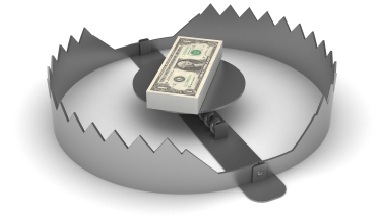
Some adjustments are made because we anticipate a specific event in the market (buy vega in anticipation of a increase in implied volatility). Others are made because we fear a big rally or decline. However, most of the time adjusters seek to find a trade that reduces risk for as many different market conditions as possible.
Traders tend to find that one specific adjustment type is their favorite because it has brought satisfactory result sin the past. Some adjustment techniques are well-suited to a specific strategy and the pair go well together. [Rolling down when trading CTM iron condors]
The trap

Some adjustment methods are so attractive because they offer a very reassuring risk graph. The problem with that adjustment type is that the graph may be deceiving. This is the topic of today’s post.
Readers who are familiar with my philosophy concerning the purchase of individual calls or puts as insurance for an iron condor trade know this: I recommend NEVER buying any option for protection when that option is farther OTM than the option (or spread) being protected. There are situations when ignoring that advice brings excellent results. However, much of the time the trader can get trapped and loses even more money than would have been lost without the adjustment.
That is a situation that has to be avoided. So let’s make this one basic premise for all iron condor adjustments:
No iron condor adjustment is acceptable when losses may become higher than that of the original trade with no adjustment
Translation: An adjustment must never add to losses. An adjustment must earn a profit (if it were a standalone trade) at any time that the position being protected loses more money that it is losing when the adjustment is made. In my opinion, there are no exceptions unless you are sophisticated enough to recognize the extreme danger and will get out of the trade early enough to prevent a disaster. Here is an example:
Example:
Let’s say you are short the 750/760 call spread for some unspecified index. Wanting protection against a big rally, you buy one or more extra 760 calls. When looking at the risk graph, all we tend to notice is the large potential profit when the index rises to 800, 850, 900 etc.
However, the crucial part of the trade gets ignored (by those who have not thought this through well enough). As time passes, those extra calls lose much of their power. Sure, the graph still looks good and the position performs well when the market moves a lot higher. But that is not the scenario for which we bought protection. The adjustment trade must reduce losses when the index creeps higher and approaches the short strike.
We should not be concerned with risk when the index rallies to 850. That is an unlikely scenario. The trader has to worry about the market moving to 740, 745, 750 – especially as expiration nears. [One of my tenets is that we should not be holding positions in this very risky situation, but some traders hold anyway]. When your ‘protection’ is owning extra 760 calls, and time is getting short, those calls do not help when the rally continues slowly as the days pass. In fact, they could easily expire worthless while your short spread finishes in the money by as many as ten points.
That would be a double disaster: losing a lot of money on the original position and seeing the adjustment trade expire worthless.
The problem occurs because the trader bought calls with a higher strike than her short calls. The situation is identical when you buy puts that are farther OTM than the short puts being protected.
Unless you know the adjustment is to be held for a VERY short time and will be replaced, do not buy protection that is farther OTM than the position being protected.
Two of the most difficult aspects of managing risk for negative gamma positions is deciding when to make the adjustment and which specific trade to make as the adjustment.
Today, let’s talk about timing.
If we adjust frequently, we run the risk of buying every rally and selling every dip – exactly what we don’t want to do. If we had done nothing, we’d be holding a winning trade. On the other hand, if the market edges higher (or lower, take your pick) day after day, then these frequent adjustments could save us a pile of money because we would never be too far from delta neutral.
If we adjust in stages or at predetermined levels (price of underlying, delta of short, money lost etc.) we have exactly the same situation as above – but the numbers are all larger. If we adjust and the market reverses direction, we will have spent a decent sum adding protection when it turns out that we would have been better off not to have adjusted. And to make matters worse, we would have locked in a reasonable loss for at least a portion of the position by making that adjustment. On the other hand, if we do not make the adjustment, we own a position that is out of balance, is currently underwater, and has reached a point where we are threatened with ever-increasing additional losses. That is no time for the prudent trader to become stubborn. It is time to do something to reduce risk.
When?
There are two basic approaches:
1) Time adjustments for all trades as consistently as possible. The specific method used is less important than being consistent.
2) Use your best judgment to determine the type of market conditions under which you are trading. Use technical indicators, follow the trend, follow your gut, keep careful records of how much the index is up or down every day, etc.
If it seems as if we are in a trending bull or bear market, then adjust much more often as a safer way of managing risk. You could even initiate the trade with one adjustment built-in. [begin with an unequal iron condor, perhaps 8 calls and 10 puts; or begin with calls (or puts) with a smaller delta than the other side.]
Don’t sit and wait for a reversal that may never arrive. Trade scared and trade with safety in mind. Or don’t trade and wait for better conditions.
If it seems that the market is not trending or that you cannot draw useful conclusions about what you see, then return to your standard risk management technique. Be ready to change course for extra safety.
Bottom line: Whatever it is that you see in the market, the objective is to play it safe. Play it small. Or don’t play at all. There is a ton of money to be made by trading iron condors or selling credit spreads. But that is only true part of the time. When the markets are unfavorable for those methods, we must minimize losses so that we are in good shape to collect when it becomes our turn. And we do not know when our turn will begin or end.
Related articles:
- Should You Leg Into Iron Condor?
- Exiting An Iron Condor Trade
- Iron Condor Adjustment: Can I "Roll" It Forever?
- Why Iron Condors Are NOT An ATM Machine
- Can You Really Make 10% Per Month With Iron Condors?
- Is Your Iron Condor Really Protected?
Want to learn more?

Mark Wolfinger has been in the options business since 1977, when he began his career as a floor trader at the Chicago Board Options Exchange (CBOE). Since leaving the Exchange, Mark has been giving trading seminars as well as providing individual mentoring via telephone, email and his premium Options For Rookies blog. Mark has published four books about options. His Options For Rookies book is a classic primer and a must read for every options trader. Mark holds a BS from Brooklyn College and a PhD in chemistry from Northwestern University.



Join the conversation
You can post now and register later. If you have an account, sign in now to post with your account.
Note: Your post will require moderator approval before it will be visible.